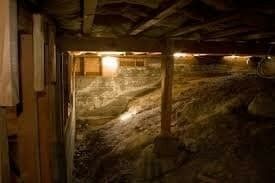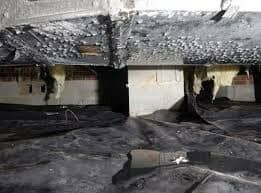
Crawl Space Cleanup: Comprehensive Guide to Removing Contaminants
Crawl spaces are often neglected areas in homes, but they play a crucial role in maintaining indoor air quality and preventing the growth of mold and mildew. Regular crawl space cleanup and remediation can eliminate contaminants such as pests, mold, moisture, and debris, ensuring a healthier living environment. This comprehensive guide will cover the importance of crawl space cleanup and remediation, the process involved, and the benefits it provides.
The Importance of Crawl Space Cleanup

A clean and well-maintained crawl space offers several advantages to homeowners:
- Improved Indoor Air Quality: The air inside a home can become contaminated if pollutants from a dirty crawl space find their way into living areas. Cleaning and sealing the crawl space can prevent pollutants from entering the home and subsequently improve indoor air quality.
- Prevention of Mold and Mildew: Crawl spaces are prone to moisture buildup, which creates an ideal environment for mold and mildew growth. Regular cleanup and remediation can eliminate moisture sources and prevent mold and mildew from spreading.
- Reduction in Pest Infestation: A dirty crawl space attracts pests such as rodents, insects, and spiders. By cleaning and sealing the crawl space, homeowners can discourage pests from entering the home and causing damage.
- Protection of Structural Integrity: Excessive moisture in the crawl space can lead to wood rot and structural damage. Cleaning and remediation help identify and address any structural issues, ensuring the long-term stability of the home.
The Crawl Space Cleanup Process
The crawl space cleanup process involves several steps:
- Inspection: A professional crawl space cleanup company will conduct a thorough inspection of the crawl space to assess the extent of contamination, moisture issues, and any structural damage.
- Contaminant Removal: The cleanup team will remove all debris, including fallen insulation, trash, and other materials. Pests, such as rodents and insects, will be exterminated and removed from the crawl space.
- Mold Remediation: If mold is present, it will be treated and removed in accordance with industry best practices. This may involve the use of specialized equipment and cleaning agents to ensure complete mold removal.
- Moisture Control: To prevent future moisture issues, the crawl space will be inspected for any water leaks or plumbing problems. Moisture control measures, such as the installation of a vapor barrier, dehumidifiers, and proper ventilation, may be implemented.
- Sealing: Gaps, cracks, and openings in the crawl space will be sealed to prevent pests and moisture from entering. This includes sealing around pipes, vents, and electrical penetrations.
- Insulation: If needed, the crawl space will be insulated to improve energy efficiency and maintain consistent temperatures throughout the home.

The Benefits of Crawl Space Cleanup and Remediation
Proper crawl space cleanup and remediation offer numerous benefits:
- Improved Indoor Air Quality: By removing contaminants and preventing their entry into the home, crawl space cleanup can significantly improve indoor air quality, reducing the risk of respiratory issues and allergies.
- Prevention of Mold and Mildew: Eliminating moisture sources and addressing mold and mildew growth helps prevent their spread, protecting the health of both the home’s occupants and the structure itself.
- Energy Efficiency: By sealing and insulating the crawl space, homeowners can reduce heat loss, lower energy consumption, and save on heating and cooling costs.
- Increased Home Value: A clean and well-maintained crawl space adds value to a home. If you’re planning to sell your property, proper crawl space cleanup and remediation can make a positive impression on potential buyers.
Crawl Space Remediation: Restoring a Healthy Living Environment
Signs That Your Crawl Space Needs Remediation
There are several signs that indicate your crawl space may require remediation:
- Mold and Mildew Growth: Mold and mildew thrive in damp environments, so the presence of a musty odor or visible mold growth is a clear indication that remediation is necessary.
- Pest Infestation: Rodents, insects, and other pests in the crawl space indicate the need for remediation. Pests can cause damage to insulation, wiring, and other components of the crawl space.
- Excessive Moisture: Standing water or dampness in the crawl space can lead to mold growth, wood rot, and structural damage. Remediation works to eliminate moisture sources and improve ventilation.
- High Utility Bills: A poorly insulated and sealed crawl space can result in heat loss or gain, leading to increased energy usage and higher utility bills. Remediation helps improve energy efficiency and reduce costs.
The Crawl Space Remediation Process
The crawl space remediation process is similar to cleanup but focuses more on addressing specific issues:
- Inspection: A professional remediation company will thoroughly inspect the crawl space to assess the extent of damage, identify the source of the problem, and develop a remediation plan.
- Moisture Control: Moisture issues will be addressed by identifying and fixing any leaks, improving drainage, and installing ventilation systems and dehumidifiers.
- Mold and Mildew Removal: All mold and mildew will be safely and effectively removed, using specialized equipment and techniques to prevent further contamination.
- Structural Repairs: Any structural damage will be repaired to restore the integrity of the crawl space and prevent future issues.
- Sealing and Insulation: Gaps and cracks in the crawl space will be sealed, and insulation will be installed to improve energy efficiency and maintain a consistent temperature.
The Benefits of Crawl Space Remediation
Crawl space remediation offers various benefits to homeowners:
- Improved Indoor Air Quality: Remediation eliminates mold, mildew, and contaminants that can negatively impact indoor air quality, leading to healthier living conditions.
- Prevention of Structural Damage: By addressing moisture issues and repairing any damage, remediation safeguards the structural integrity of the home, preventing costly repairs in the future.
- Energy Efficiency: Sealing and insulating the crawl space can reduce energy loss, resulting in lower utility bills and increased energy efficiency.
- Peace of Mind: Knowing that your crawl space is clean, dry, and free from mold and pests provides peace of mind and ensures a healthy living environment for you and your family.
Crawl Space Insulation: Improving Energy Efficiency and Comfort
The Importance of Crawl Space Insulation
Insulating your crawl space offers several benefits:
- Energy Efficiency: Insulation prevents heat loss or gain through the crawl space, reducing the need for heating and cooling and lowering energy bills.
- Improved Comfort: Proper insulation helps maintain a consistent temperature throughout the home, ensuring comfort in every season.
- Moisture Control: Insulation acts as a barrier against moisture, preventing condensation and reducing the risk of mold and mildew growth.
- Reduced Noise: Insulation helps minimize sound transmission between the crawl space and living areas, improving overall acoustic comfort.
The Types of Crawl Space Insulation
There are several types of insulation commonly used for crawl spaces:
- Spray Foam Insulation: This type of insulation creates an airtight seal, effectively minimizing heat transfer and sealing gaps and cracks.
- Fiberglass Insulation: Fiberglass batts or rolls are commonly used in crawl spaces. They are easy to install and provide good thermal performance.
- Blown-in Insulation: Blown-in insulation is made of loose fill material, such as cellulose or fiberglass. It is useful for insulating irregularly shaped crawl spaces.
- Rigid Foam Insulation: Rigid foam boards provide excellent thermal resistance and moisture resistance. They are ideal for insulating crawl space walls.
The Process of Crawl Space Insulation
The process of insulating a crawl space typically involves the following steps:
- Clean and Prep: The crawl space is cleaned and prepared, ensuring all debris, pests, and contaminants are removed.
- Seal Air Leaks: Any gaps, cracks, or openings in the crawl space are sealed to prevent air leakage.
- Install Vapor Barrier: A vapor barrier is installed on the crawl space floor and walls to prevent moisture intrusion.
- Insulate Walls: Insulation is added to the walls of the crawl space, ensuring maximum thermal efficiency.
- Insulate Floor: Insulation is installed between the floor joists, reducing heat transfer between the crawl space and living areas.
- Seal and Encapsulate: The crawl space is sealed and encapsulated to create a conditioned space that is separate from the external environment.
The Benefits of Crawl Space Insulation
Proper crawl space insulation offers a range of advantages:
- Energy Savings: Insulating the crawl space can reduce energy costs by preventing heat loss or gain, resulting in lower heating and cooling bills.
- Improved Comfort: By maintaining a consistent temperature, crawl space insulation ensures greater comfort throughout the home.
- Protection Against Moisture: Insulation helps prevent moisture buildup, reducing the risk of mold and mildew growth and protecting the structural integrity of the home.
- Noise Reduction: Insulation can help minimize noise transmission between the crawl space and living areas, creating a quieter indoor environment.
FAQ Question 1: How often should crawl space cleanup be performed?
FAQ Question 2: Can crawl space cleanup be done as a DIY project?
For professional crawl space cleanup and remediation services, contact Service Water Restoration Pros. Our team of experts is dedicated to improving indoor air quality and creating healthier living environments.
Sources:
– EPA – Biological Contaminants in Crawl Spaces
– ENERGY STAR – Types of Insulation
– The Spruce – Crawl Space Insulation Basics


